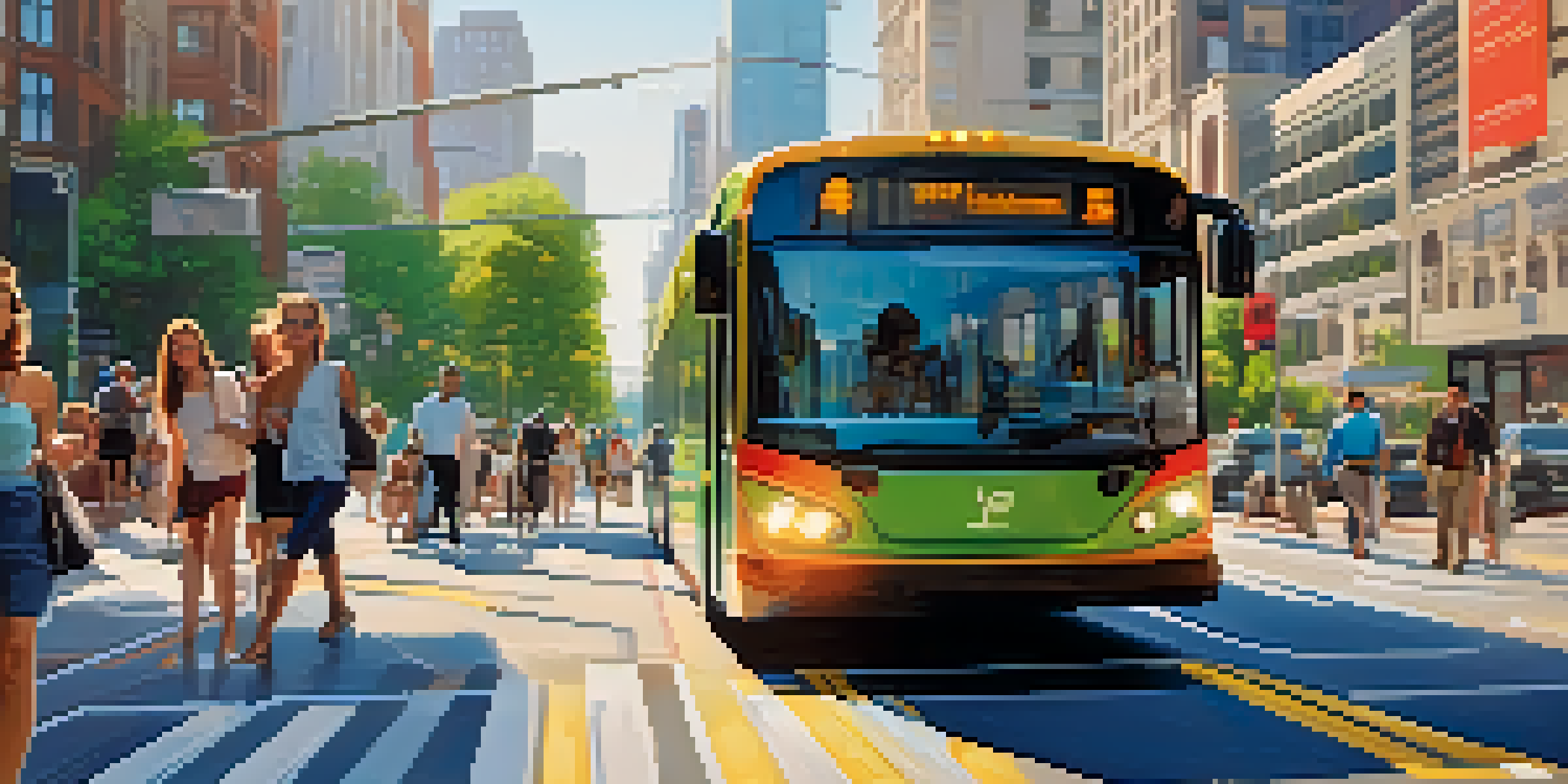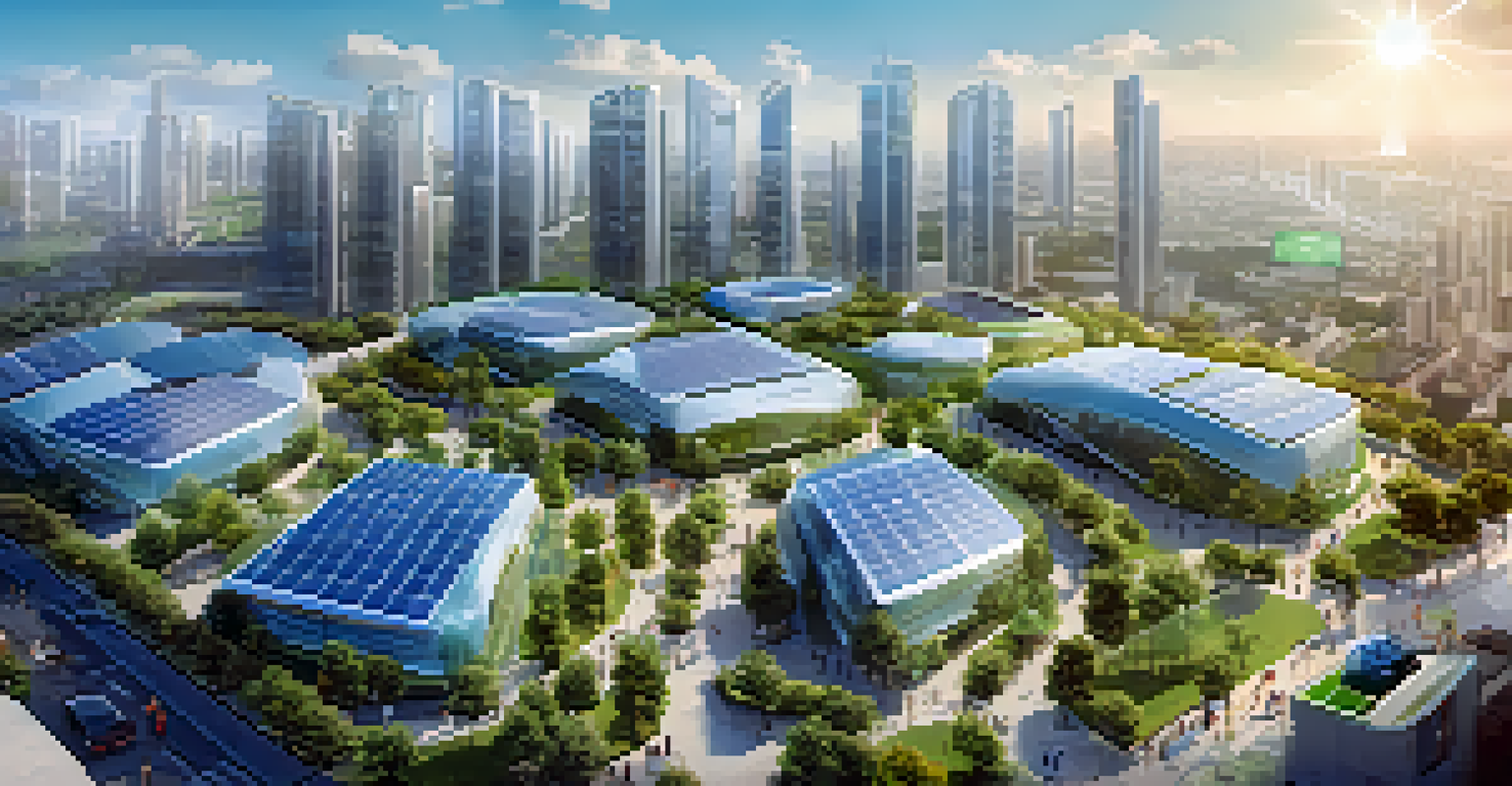The Role of IoT in Future Smart City Developments

Understanding IoT and Its Importance in Urban Planning
The Internet of Things (IoT) refers to a network of interconnected devices that communicate and exchange data. This technology is pivotal in urban planning as it enables cities to optimize resources and improve the quality of life for residents. Imagine a city where traffic signals adapt in real-time to traffic flow, reducing congestion and emissions. This is just one example of how IoT can transform urban environments into more efficient and sustainable spaces.
The Internet of Things is not a concept; it is a network of connected devices that can change the way we live and work.
As urban populations grow, the challenges of managing infrastructure, energy consumption, and public services become increasingly complex. IoT devices offer innovative solutions by providing real-time data that city planners can use to make informed decisions. For instance, smart sensors can monitor air quality, allowing cities to address pollution hotspots and enhance public health proactively.
Moreover, integrating IoT into city planning fosters collaboration among various stakeholders, such as government agencies, businesses, and citizens. By working together, these groups can co-create solutions that reflect the needs and desires of the community, ultimately leading to more livable and resilient cities.
Smart Transportation Systems Powered by IoT
Transportation is a critical aspect of urban living, and IoT has the potential to revolutionize how we navigate our cities. Smart transportation systems can provide real-time information on traffic conditions, public transit schedules, and even available parking spots. This not only reduces frustration for commuters but also helps decrease overall traffic congestion.

For example, consider a city where public buses communicate with traffic lights to ensure they maintain optimal speeds and minimize delays. This kind of integration can make public transportation more appealing, encouraging more people to leave their cars at home. Additionally, ride-sharing platforms can utilize IoT data to match riders efficiently, further streamlining urban mobility.
IoT Enhances Urban Planning Efficiency
The integration of IoT in urban planning allows cities to optimize resources and improve residents' quality of life through real-time data.
The benefits of smart transportation extend beyond convenience; they also contribute to environmental sustainability. By optimizing traffic flow and encouraging the use of public transit, cities can reduce greenhouse gas emissions and create healthier urban spaces. In this way, IoT is not just enhancing transportation; it's also promoting a greener future.
Enhancing Public Safety with IoT Solutions
Public safety is a top priority for any city, and IoT technologies can significantly enhance safety measures. From smart streetlights that improve visibility at night to surveillance cameras equipped with advanced analytics, IoT can help cities respond to emergencies more effectively. For instance, if a crime is detected, authorities can receive real-time alerts, allowing for quicker intervention.
Technology is best when it brings people together.
Moreover, IoT can facilitate better disaster management by providing critical data during emergencies. Sensors can monitor environmental conditions, like flooding or earthquakes, and inform residents and officials about imminent threats. This proactive approach not only saves lives but also minimizes property damage and recovery costs.
Community engagement is another vital component of public safety, and IoT can foster this by enabling citizen reporting through mobile apps. Residents can report issues such as potholes or suspicious activities, creating a collaborative environment where everyone plays a role in maintaining their community's safety.
Energy Management and Sustainability in Smart Cities
Energy consumption is a significant concern for urban areas, and IoT technologies are key to managing this resource more sustainably. Smart grids, equipped with IoT sensors, can monitor energy usage in real-time and adjust supply accordingly, reducing waste and lowering costs for consumers. This creates a more efficient energy ecosystem that benefits both the environment and residents.
For instance, smart buildings equipped with IoT devices can optimize heating, cooling, and lighting based on occupancy patterns. By analyzing data, these buildings can minimize energy consumption without sacrificing comfort. This level of efficiency is essential for cities striving to meet sustainability goals.
Smart Transportation Reduces Congestion
IoT-powered smart transportation systems provide real-time information, making public transit more appealing and reducing overall traffic congestion.
Additionally, integrating renewable energy sources, such as solar panels, with IoT technology allows for better energy distribution and management. Cities can harness clean energy while also ensuring that they are prepared for fluctuations in supply and demand, making the urban landscape more resilient and environmentally friendly.
Smart Waste Management Systems and Their Benefits
Waste management is a pressing issue for cities worldwide, and IoT can offer innovative solutions to streamline this process. Smart waste bins equipped with sensors can monitor fill levels and optimize collection routes for garbage trucks. This not only saves fuel but also ensures that waste is collected before it overflows, maintaining cleaner public spaces.
For example, a city implementing smart waste management can reduce collection costs by up to 30% through optimized routes and schedules. This efficiency translates into lower operational costs and a smaller carbon footprint, benefiting both the city budget and the environment.
Furthermore, IoT can promote recycling and waste reduction by providing data on waste generation patterns. This information can help cities implement targeted programs that encourage residents to recycle more and reduce overall waste production, leading to a more sustainable urban environment.
The Role of IoT in Urban Health and Well-being
Health is a critical aspect of urban living, and IoT can play a significant role in promoting public health and well-being. Smart healthcare solutions, such as connected devices and wearable technology, can monitor health metrics and provide personalized care. For instance, residents can receive alerts about health risks in their area, such as air quality issues or disease outbreaks.
Additionally, IoT can enhance access to healthcare services by connecting patients with providers remotely. Telehealth solutions enable consultations without the need for in-person visits, making healthcare more accessible to those with mobility issues or those living in underserved areas. This promotes a healthier population and reduces the strain on healthcare facilities.
Public Safety Improved by IoT Tech
IoT technologies enhance public safety by enabling faster emergency responses and facilitating community engagement through citizen reporting.
Moreover, smart city initiatives can encourage physical activity and mental well-being through connected public spaces. For example, parks equipped with fitness trackers and social engagement platforms can motivate residents to participate in outdoor activities, ultimately fostering a healthier lifestyle and stronger communities.
Challenges and Considerations for IoT Implementation
While the potential benefits of IoT in smart city developments are immense, several challenges must be addressed to ensure successful implementation. Privacy and security concerns are at the forefront, as the vast amount of data collected can be vulnerable to breaches. Cities must establish robust cybersecurity measures and transparent policies to protect residents' information.
Additionally, the integration of diverse IoT devices and systems can be complex, requiring collaboration among various stakeholders. Cities need to develop standardized protocols and frameworks to ensure that these technologies work seamlessly together. This collaboration fosters innovation while minimizing redundancy and inefficiencies.

Finally, it's essential to consider the digital divide when implementing IoT solutions. Ensuring equitable access to technology and resources is vital for all community members to benefit from smart city initiatives. By prioritizing inclusivity, cities can create environments where everyone can thrive and enjoy the advantages of IoT.
The Future of Cities: A Vision of IoT Integration
Looking ahead, the future of cities will undoubtedly be shaped by the ongoing integration of IoT technologies. As cities continue to evolve, we can anticipate even more innovative applications that enhance urban living and promote sustainability. From smart homes that adapt to residents' needs to intelligent transportation networks that facilitate seamless mobility, the possibilities are endless.
Moreover, the collaborative nature of smart city initiatives means that residents will have a more active role in shaping their communities. Engaging citizens in the planning process allows for diverse perspectives to be considered, ultimately leading to more inclusive and responsive urban environments. This participatory approach fosters a sense of ownership and connection among residents.
Ultimately, the successful integration of IoT into smart city developments requires a commitment to innovation, collaboration, and sustainability. By embracing these principles, cities can create vibrant, resilient, and sustainable environments that enhance the quality of life for all their residents.